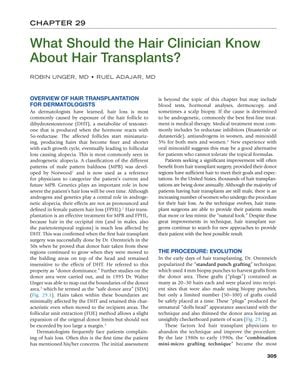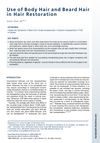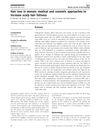What Should the Hair Clinician Know About Hair Transplants?
January 2019

TLDR Hair transplants are effective for male and female pattern baldness, have evolved in technique, and require careful planning for natural results and managing complications.
The document from 2019 provides a comprehensive overview of hair transplantation, detailing its effectiveness for male pattern baldness (MPB) and female pattern hair loss (FPHL), the evolution of techniques from punch grafting to follicular unit transplantation (FUT), and the two primary methods of FUT: the strip method and follicular unit extraction (FUE). It highlights the importance of graft placement, the use of holding solutions and platelet-rich plasma (PRP) to improve graft survival, and the postoperative course, which includes potential complications such as forehead edema and "shock loss." The document also discusses the application of hair transplantation in various areas and the need for careful planning to achieve natural results. For scarring and cicatricial alopecia, it advises multiple transplant sessions and waiting periods to ensure inactive disease before proceeding. It mentions the use of PRP and ACell Matristem, but notes that further studies are needed to establish these as standard treatments. The document does not report on specific studies or the number of people involved, as it serves as an instructional text rather than a study report.
View this study on doi.org →
Related

research What Should the Hair Clinician Know About Hair Transplants?
Hair transplants are effective for male and female pattern baldness, have evolved in technique, and require careful planning for natural results and managing complications.

research The Use of Body Hair with Scalp Hair for “Combination Grafting” to Enhance Visual Density of Hair Transplantation and Increase Coverage in Advanced Alopecia
Using body hair with scalp hair for hair transplants improves density and coverage in severe hair loss cases.

research Hair disorders
The document's conclusion cannot be provided because the document cannot be parsed.

research Hair loss (alopecia or baldness)
Baldness is often hereditary and linked to male hormones, becoming noticeable when half the hair is lost.

research Body to scalp: Evolving trends in body hair transplantation
Body hair transplants can treat baldness but differ from scalp hair and need more research on long-term results and side effects.

research Body Hair Transplant by Follicular Unit Extraction: My Experience With 122 Patients
Body hair transplantation is an effective method for restoring hair in people with severe baldness and limited scalp donor hair.

research Use of Body Hair and Beard Hair in Hair Restoration
Body and beard hair can be used for hair restoration in severely bald patients, but the technique is complex and costly.

research Hair loss in women: medical and cosmetic approaches to increase scalp hair fullness
Female pattern hair loss can be treated with medications, surgery, and cosmetic products, considering its psychological impact.